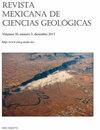Revisiting the Cupidito unit (Cupido Formation) along peritidal carbonates from northeastern Mexico
IF 0.5
4区 地球科学
Q4 GEOSCIENCES, MULTIDISCIPLINARY
Revista Mexicana De Ciencias Geologicas
Pub Date : 2020-03-31
DOI:10.22201/cgeo.20072902e.2020.1.1095
引用次数: 3
Abstract
Depositional episodes are readily identified along representative localities of the Lower Cretaceous Cupido platform in northeastern Mexico. The basal part of the Cupido Formation exhibits a progradational reef platform that, at the upper limit, is truncated by a sequence boundary defined by a breccia. This breccia marks the development of a peculiar sedimentary facies informally known as the Cupidito unit, a distinctive stratigraphical unit in northeastern Mexico that remained uninterpreted for decades. Through the analysis of facies, microfacies and stable isotope comparisons from representative localities (Potrero Chico, Potrero de García, La Huasteca, La Muralla and Puerto Mexico) and from other previously reported outcrops, this work describes six diagnostic features for Cupidito and an improved stratigraphic model is proposed. The depositional sequence suggests a broad flat-topped platform with a general low organic productivity and restricted conditions followed by recurrent inundations of lagoon waters. Before drowning, this carbonate platform remained under equilibrium conditions interrupted by short pulses of relative higher-temperatures (48.3 °C and 39.2 °C). Coral-rudist-stromatoporoid patch-reefs with inferred inter-tropical temperatures between 31.5 °C and 32.2 °C originated as a progradational response to the instauration of a new Sequence Boundary at the base of Cupidito.沿墨西哥东北部潮外碳酸盐岩重新考察丘比特多组
沿墨西哥东北部下白垩世丘比多地台的代表性地点很容易确定沉积期。丘比多组基底部为递进式礁台,其上限为角砾岩层序边界截断。这个角砾岩标志着一种特殊沉积相的发展,这种沉积相被非正式地称为丘比特托单元,这是墨西哥东北部一个独特的地层单元,几十年来一直没有得到解释。通过对代表性地点(potreo Chico、potreo de García、La Huasteca、La Muralla和Puerto Mexico)和其他已报道露头的相、微相和稳定同位素对比分析,描述了丘比地托的6个诊断特征,并提出了改进的地层模式。沉积层序表明,这是一个广泛的平顶台地,有机生产力普遍较低,条件有限,随后是泻湖水域的反复淹没。在淹没之前,这个碳酸盐台地一直处于平衡状态,被相对较高的温度(48.3°C和39.2°C)的短脉冲打断。推断热带温度在31.5 ~ 32.2℃之间的珊瑚-海陆-叠层状斑状礁是对丘比地底新层序边界恢复的递进响应。
本文章由计算机程序翻译,如有差异,请以英文原文为准。
求助全文
约1分钟内获得全文
求助全文
来源期刊

Revista Mexicana De Ciencias Geologicas
地学-地球科学综合
CiteScore
1.00
自引率
12.50%
发文量
0
审稿时长
6-12 weeks
期刊介绍:
Revista Mexicana de Ciencias Geológicas (RMCG) publishes original research papers on geological processes of broad interest, and particularly those dealing with regions of Latin America. The RMCG also publishes review papers on topics of current interest, and on the geology and tectonics of geological provinces of Latin America. Besides, it offers the opportunity for host editors to publish special thematic issues.
 求助内容:
求助内容: 应助结果提醒方式:
应助结果提醒方式:


